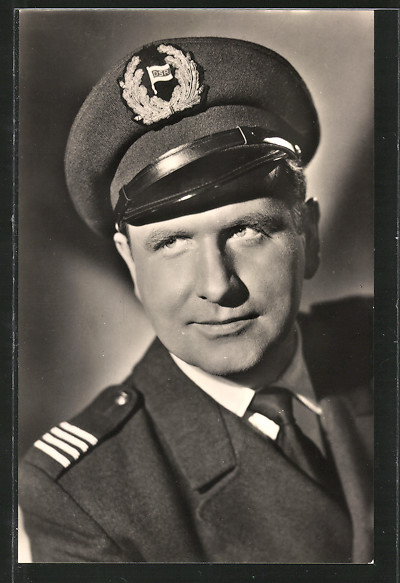Günther Simon (Günther Simon)

A bank clerk’s son, Günther Simon attended an acting school already in Gymnasium. At the age of 16, he was sent to a premilitary training camp of the Hitler Youth and then drafted to the Reich Labour Service. He volunteered to join the paratroopers in August 1943. He was captured by American troops near Normandy and shipped to a POW camp in Colorado, where he acted in the camp’s makeshift theater. After returning home in 1947, Simon took private acting lessons with Karl Meixner in the Hebbel Theater. He made his debut on stage in the Municipal Theater of Köthen at 1948, in a production of Dmitry Scheglov’s The Storm. He then moved to the Schwerin Theater, in which he remained until 1950; there, he met his wife Margarita, who was employed as a dancer. Afterwards, Simon joined the cast of the Dresden Theater. In late 1951, he left it in favour of the Leipzig Theater, where he remained for only a short period.
Günther Simon was cast for one of the leading roles in the 1952 film The Condemned Village, and since then was active mainly in cinema. At the same year, in spite of his inexperience, he was chosen to portray Ernst Thälmann in Kurt Maetzig’s two-part propaganda epic about the communist leader’s life. The picture was watched by millions and entered the East German schools’ curriculum. Simon received the National Prize first class for his work on the first part, and the Best Actor Award in the 1956 Karlovy Vary International Film Festival for his appearance in the second. He joined the country’s Socialist Unity Party of Germany (SED / Sozialistische Einheitspartei Deutschlands) in 1954 and became a member of the DEFA Studio’s management. Günther Simon appeared in some 30 pictures throughout the years. In 1956, he was awarded the Heinrich Greif Prize second class. He won the National Prize once more, in 1968, for his portrayal of Krause in the television miniseries Krause and Krupp, and received the Art Prize of the Free German Trade Union Federation thrice, in 1967, 1968, and 1971. He had three sons and one daughter, and is buried in the Dorotheenstadt cemetery.
Born
- May, 11, 1925
- Berlin, Germany
Died
- June, 25, 1972
- Berlin, Germany
Cemetery
- Dorotheenstädtisch-Friedrichwerderscher Friedhof I
- Berlin, Germany



